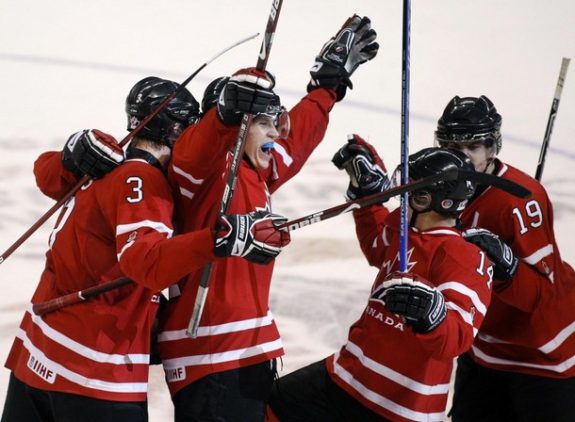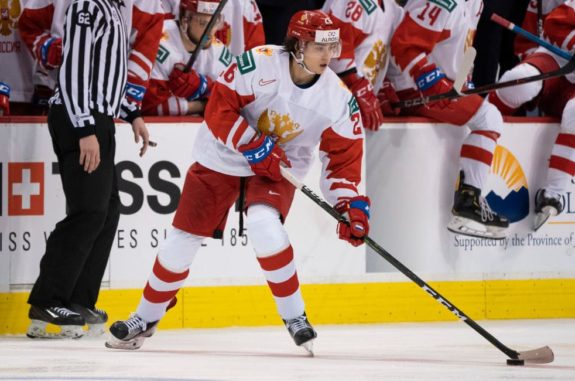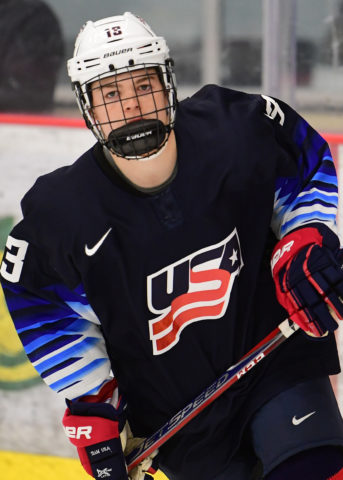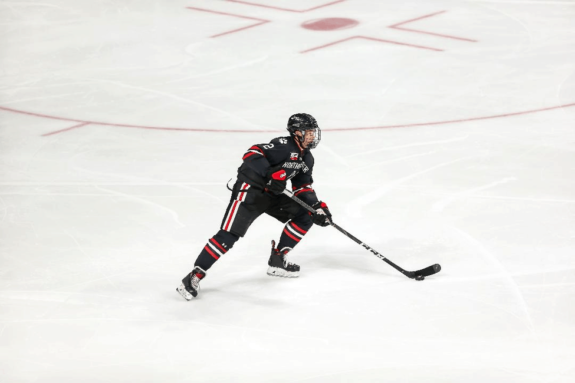
 James Yates
The Hockey Writers
James Yates
The Hockey Writers
28
Reads
0
Comments
Montreal Canadiens’ Prospects at the World Juniors
The World Junior Hockey Championship is the best showcase for young players either drafted or undrafted. It’s a Christmas tradition to watch Team Canada go for gold starting on boxing day, and this year will be no different in my house. The tournament is also a great chance for organizations to see their prospects play against the best competition they can, and if they can take their games to another level.
It’s a lot of games in a short amount of time, and can make for high-drama, high-intensity hockey. While it is just one event that can be over in four games for some teams, many analysts and hockey executives put lots of stock into it, based on it’s sink or swim nature and the pressure it puts on young players. It’s given us some memorable moments over the years. Who can forget Carey Price and Jonathan Toews in the shootout in 2007? Or Jordan Eberle tying the semi-final game with two seconds left against the Russians?

Historically, the Montreal Canadiens have been well represented at the event. Players like PK Subban, Price, Ryan Poehling, and Brendan Gallagher were all standouts at the World Juniors, and many other players drafted by Montreal have participated in the tournament over the years. Last year was an especially good one for Canadiens’ prospects, with Poehling winning MVP of the tournament, and Alexander Romanov winning best defenceman honors. This year should be no different and with four prospects participating.
Alexander Romanov (Team Russia)
Since being selected in the 2nd round of the 2018 NHL Draft, Romanov’s stock has continually risen. He burst onto the scene at the 2018-2019 World Juniors as a hard-hitting, steady defenceman. General Manager Marc Bergevin took heat when he drafted Romanov, because many thought he would go much later, and 38th overall was far too early, (from: ‘Alexander Romanov was a surprise pick by Canadiens’ at NHL Draft’, Montreal Gazette, 06/26/18). But Bergevin wanted to make sure he grabbed him when he had the chance, and for good reason.
Romanov is one of those all-around defenceman who can do everything well. He averaged 11:23 of ice time as an 18-year-old last year and is up to 12:06 this season. He’s only managed 8 points in 76 games, and though that isn’t eye-popping, he was playing against men when most players his age are playing against their peers. When he did play against his peers at last year’s tournament, he amassed eight points in seven games along with MVP honors. A transition to the smaller ice-surface may not be as difficult as many expect.

This year’s tournament shouldn’t be any different for Romanov, as he’s expected to lead a talented team Russia as far as he can take them. Bergevin is hoping for another strong performance from his prized prospect, and met with him in the hopes that he will make the jump to the NHL next season, when his KHL contract expires. He’s exactly what the Canadiens need in terms of a top-four left shot defenceman, and he can further plead this case with another strong World Junior performance.
Cole Caufield (Team USA)
Falling to 15th overall in 2018, Cole Caufield was passed over at the draft by a lot of teams due to his size. At just 5-foot-7 and 162 pounds, it’s understandable that some organizations felt he couldn’t handle the physicality of the NHL. But he’s been proving people wrong his entire young career.
Though he wasn’t particularly effective in team USA’s first two round robin games against Canada and Germany, Caufield had a four-goal performance in his final preliminary game against those same Germans. He’s talented with the ability to get lost among the bodies on the ice, and when he gets his shot off, it’s lethal. It’s an unteachable skill, you either have it or don’t, and he has it in spades. Team USA is favored to reach the gold medal game and Caufield is a big reason for that.

He started his NCAA career with a bang at the University of Wisconsin. In 18 games with the Badgers, Caufield has 12 goals and 8 assists. Head coach Tony Granato had high praise for his rookie winger, saying his hockey IQ is already “NHL level”. He’s very similar to fellow Canadiens rookie Nick Suzuki in that regard and hopefully, Caufield can become more impactful as the tourney goes on.
Jordan Harris (Team USA)
Playing in his second season at Northwestern University, Jordan Harris has already equaled his point total (18) from last season in almost half the games played (39). He’s flown under the radar until this season when his point totals shot up and he was able to make team USA. He’s played a prominent role so far for Team USA.

Drafted in the third round, 71st overall by Montreal in 2018, Harris has played top-four minutes for Northeastern University as well as team USA and could be another left-side defensive option for the Canadiens going forward. He’s had a decent start to the tournament with a goal in the second tilt versus Germany, but was beat on the then go-ahead goal for the Germans in the second period. It’s a tiny concern about his game (getting beat off the rush) that can be cleaned up when he gets to Montreal or Laval.
Mattias Norlinder (Team Sweden)
Acquired as part of the package for Max Pacioretty, the 2nd round pick in 2019 eventually turned into Swedish rearguard Mattias Norlinder. Like Harris, Norlinder has improved considerably in his second year of meaningful hockey, registering 14 points in 28 games this season in the Swedish Elite League.
He’s a smart player who is very creative with the puck and has an above-average shot to go along with everything else. Team Sweden will be led by Rasmus Sandin and Adam Boqvist on the blue line, but aside from them, there’s an opportunity for a player like Norlinder to raise his stock to the number three defenceman on their depth chart.
When Montreal finally realized that their left side on defense was weak on their roster and in their prospect pool, they made a conscious effort to target left-shot d-men. Norlinder is part of a cluster players (including Harris) who will be competing for a spot on Montreal’s blue line in the next one to three seasons. Sweden is in the relatively easy Group A and should have no problem advancing in the tournament. It will be interesting to see if Norlinder can raise his game in this short span to be more comparable to Sandin and Boqvist.
No matter how well or poorly their teams do in this tournament, Montreal’s participating prospects have a chance to further improve their games and to show the Canadiens’ brass that they are elite compared to their peers. It’s a crucial chapter in their development, and I can’t wait to see what happens.
All Your THW 2020 World Junior Championship Coverage
The post Montreal Canadiens’ Prospects at the World Juniors appeared first on The Hockey Writers.
Popular Articles

















































 Blackhawks Chicago
Blackhawks Chicago Panthers Florida
Panthers Florida Penguins Pittsburgh
Penguins Pittsburgh Rangers New York
Rangers New York Avalanche Colorado
Avalanche Colorado Kings Los Angeles
Kings Los Angeles Maple Leafs Toronto
Maple Leafs Toronto Bruins Boston
Bruins Boston Capitals Washington
Capitals Washington Flames Calgary
Flames Calgary Oilers Edmonton
Oilers Edmonton Golden Knights Vegas
Golden Knights Vegas Senators Ottawa
Senators Ottawa Lightning Tampa Bay
Lightning Tampa Bay Flyers Philadelphia
Flyers Philadelphia Islanders New York
Islanders New York Sabres Buffalo
Sabres Buffalo Red Wings Detroit
Red Wings Detroit Devils New Jersey
Devils New Jersey Hurricanes Carolina
Hurricanes Carolina Blue Jackets Columbus
Blue Jackets Columbus Predators Nashville
Predators Nashville Stars Dallas
Stars Dallas Jets Winnipeg
Jets Winnipeg Wild Minnesota
Wild Minnesota Blues St. Louis
Blues St. Louis Mammoth Utah
Mammoth Utah Sharks San Jose
Sharks San Jose Canucks Vancouver
Canucks Vancouver Ducks Anaheim
Ducks Anaheim


